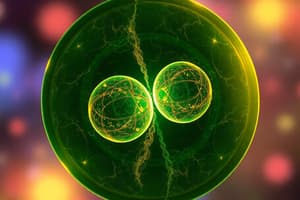Podcast
Questions and Answers
मिटोसिस और मायोसिस में मुख्य अंतर क्या है?
मिटोसिस और मायोसिस में मुख्य अंतर क्या है?
- मिटोसिस में क्रोमोसोम का जोड़ा बनता है, जबकि मायोसिस में नहीं
- मिटोसिस में सभी क्रोमोसोम अलग हो जाते हैं, जबकि मायोसिस में केवल आधे क्रोमोसोम अलग होते हैं
- मिटोसिस में जीन विनिमय होता है, जबकि मायोसिस में नहीं
- मिटोसिस में क्रोमोसोम अलग होते हैं और मायोसिस में क्रोमोसोम जोड़े बनाते हैं (correct)
कोशिका विभाजन किन जैविक प्रक्रियाओं में महत्वपूर्ण भूमिका निभाता है?
कोशिका विभाजन किन जैविक प्रक्रियाओं में महत्वपूर्ण भूमिका निभाता है?
- केवल जनन
- वृद्धि, विभेदन और ऊतक मरम्मत (correct)
- केवल ऊतक मरम्मत
- केवल वृद्धि और विभेदन
कैंसर कैसे विकसित होता है?
कैंसर कैसे विकसित होता है?
- कोशिकाओं के कम विभाजन के कारण
- अनियंत्रित कोशिका प्रवर्धन के कारण (correct)
- कोशिकाओं के अत्यधिक विभाजन के कारण
- कोशिकाओं के विभेदन के कारण
एन्युप्लॉइडी क्या है और इसका कैंसर से क्या संबंध है?
एन्युप्लॉइडी क्या है और इसका कैंसर से क्या संबंध है?
कैंसर से निपटने के लिए किन तकनीकों पर शोध किया जा रहा है?
कैंसर से निपटने के लिए किन तकनीकों पर शोध किया जा रहा है?
Study Notes
Article
Understanding Cell Division: Mitosis, Meiosis, and Their Implications in Growth, Differentiation, and Cancer
Cell division is a fundamental aspect of life, enabling the growth of multicellular organisms, ensuring proper development, and allowing for repair and regeneration of tissues. It involves the duplication of genetic material and subsequent splitting of the cell, resulting in two genetically identical daughter cells. However, cell division can malfunction, leading to various issues, including uncontrolled cell proliferation associated with cancerous growths.
Mitosis
Mitosis is the primary mode of cell division in most organisms, responsible for producing diploid (two sets of chromosomes) daughter cells. It consists of four main phases: interphase, prometaphase, metaphase, and anaphase followed by telophase. During interphase, the cell prepares for division by copying its DNA, forming sister chromatids held together by centromeres. In prometaphase, the nuclear envelope breaks down, and spindle fibers attach to the chromatin. Metaphase marks the alignment of chromosomes along the equatorial plane due to these spindle fibers. During anaphase, the sister chromatids separate and move towards opposite poles of the cell, assisted by spindle fibers. Finally, in telophase, the nucleus reforms around separated chromatids, chromosomes condense, and the nuclear envelope reforms.
Meiosis
Meiosis, on the other hand, is a specialized type of cell division occurring exclusively in germline cells (spermatocytes and oogonia), generating gametes (haploid cells) containing half the number of chromosomes as the original diploid cell. Meiosis I consists of prophase I, metaphase I, anaphase I, and telophase I, while meiosis II comprises prophase II, metaphase II, anaphase II, and telophase II (similar to the steps in mitosis). Key differences are that chromosomes pair up and exchange genetic material during prophase I, and homologous chromosomes separate during meiosis I. This process ensures genetic variability in offspring since each gamete receives unique combinations of maternal and paternal alleles.
Applications of Cell Division and Related Processes
Cell division plays critical roles in various biological processes, including growth, differentiation, and tissue repair. As new cells are formed, they can differentiate into specific cell types that contribute to the formation of tissues, organs, and physiological systems. Conversely, if dead or damaged cells need to be replaced, mitosis ensures the production of identical replacement cells. Moreover, errors during mitotic cell divisions can lead to uncontrolled cell proliferation, manifesting as cancerous growths.
Challenges and Clinical Relevance
Unchecked cell division caused by genetic mutations, environmental factors, or dysregulated signaling pathways can result in cancer. For example, continued duplication of chromosomes without proper segregation leads to aneuploidy, a common characteristic of cancerous cells. To counteract this issue, researchers explore techniques such as targeted gene therapy, immunotherapy, and stem cell transplantation, which aim to restore normal cellular function, reduce tumor size, and enhance patient survival.
Studying That Suits You
Use AI to generate personalized quizzes and flashcards to suit your learning preferences.
Description
इस क्विज़ में सेल विभाजन के महत्वपूर्ण पहलुओं को समझें: माइटोसिस और मेयोसिस जो बहुकोशीय जीवों की वृद्धि, विभिन्नता और कैंसर के संदर्भ में महत्वपूर्ण हैं।




